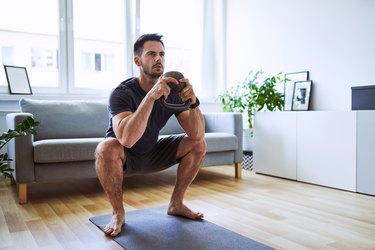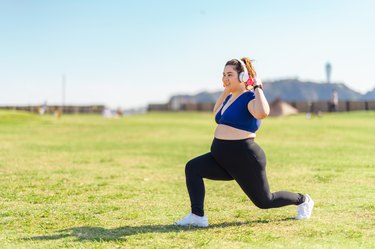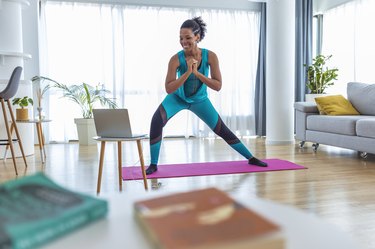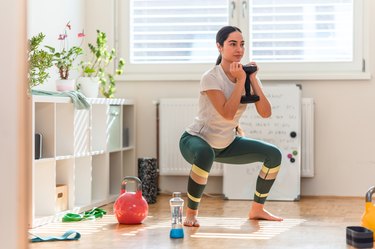

Dedicating two to three leg days a week can make a huge difference not only in your strength goals but also in your everyday life.
"Every time you sit, you squat. Every time you bend over to pick something up, you hinge. Every time you walk or climb stairs, you are on a single leg," explains Jenna Langhans, a New York City-based personal trainer and founder of Ballet & Bells.
Video of the Day
That's why it's also important to make sure your leg day includes different movement patterns and directions so you can feel strong in all kinds of daily movement. But not everyone is going to train at the same level, so make sure you're including appropriate exercises to get the most effective workouts.
"If the move is wildly too advanced for you, it will not be beneficial because you won't be able to do it with proper form," Langhans says. "We're looking for the 'Goldie Locks' of movements, where the load/movement challenges you but doesn't break you down."
With that in mind, the following leg-day workout created by Langhans includes a base move and a regression (easier) and progression (harder) so that you can tailor it to your current fitness level. She suggests starting with the base move with just your body weight to see if you can perform it. Over time, you can level up to the harder moves.
Try This 20-Minute Leg Day Workout, According to Ability Level
Do each exercise for 60 seconds, then repeat for 3 rounds, resting as needed.
For each exercise, pick the base, progression or regression that best fits your body. You can do these moves with a kettlebell (as pictured), dumbbell, barbell or whatever weights you have on hand. Langhans recommends doing this workout 1 to 2 times per week, depending on what your other training days look like, for the best results.

Move 1: Split Squat
Base Move: Isometric Split Squat
- Start in a split stance and hold your hand in front of your chest. Pull your shoulder blades back and down, brace your core and tuck your pelvis under so that your lower back is not arched.
- Bend both knees until your back knee almost touches the floor and your front thigh is parallel to the floor, or as low as you can go comfortably. Make sure that your back knee is aligned with your hip, and your front knee is aligned with your ankle.
- Hold this position for 30 seconds and then repeat on the other side.
Regression: Assisted Split Squat Hold
- Start in a split stance next to a chair so that you can hold onto the back of it for help balancing. Pull your shoulder blades back and down, brace your core and tuck your pelvis under so that your lower back is not arched.
- Bend both knees until your back knee almost touches the floor and your front thigh is parallel to the floor, or as low as you can go comfortably.
- Hold this position for 30 seconds and then repeat on the other side.
Progression: Split Squat Pulse
- Start in a split stance and hold your hand in front of your chest. Pull your shoulder blades back and down, brace your core and tuck your pelvis under so that your lower back is not arched.
- Bend both knees until your back knee almost touches the floor and your front thigh is parallel to the floor, or as low as you can go comfortably.
- Slowly pulse up and down, keeping your feet stable, your torso upright and your core braced.
- Continue pulsing for 30 seconds and then repeat on the other side.
The split squat trains your quads, hips, calves and core, Langhans says. “If clients are experiencing knee pain or discomfort, I always run them through split squats to strengthen the quad and take pressure off the knee joint.”
Move 2: Goblet Squat
Base: Goblet Squat
- Stand with your feet wider than hip-width apart, feet slightly turned out. Hold the weight with both hands at the center of your chest.
- Hinge forward at the hips and bend your knees to sink into a squat, keeping your core tight and your chest upright. Lower down for 3 counts.
- Press through your heels to return to standing. Take 1 count to stand back up.
- Do 5 reps.
Regression: Body-Weight Squat
- Stand with your feet wider than hip-width apart, feet slightly turned out. Extend your arms out in front of you.
- Hinge forward at the hips and bend your knees to sink into a squat, keeping your core tight, chest upright, and arms extended. Lower down for 3 counts.
- Press through your heels to return to standing. Take 1 count to stand back up.
- Do 5 reps.
Progression: Single-Arm Front Rack Squat
- Stand with your feet wider than hip-width apart and slightly turned out. Place a kettlebell between the arches of your feet and clean it up with one arm to the front-rack position. If you’re using a dumbbell, hold it by the handle and rest it on your shoulder with your elbow pointing down. Hold your other arm out to the side to help with balance.
- Send your hips back and bend your knees to lower down into a squat, keeping your core tight and your chest upright. Take 3 counts to lower down.
- Press through your heels to return to standing. Take 1 count to stand back up.
- Do 5 reps on each side.
“Squats are one of the most important exercises for long-term strength and health,” Langhans says. That’s because it’s super functional: Training your body to squat down and stand back up helps keep you strong in everyday movements, like sitting down in a chair and getting back up.
Move 3: Lateral Lunge
Base: Kettlebell Lateral Lunge
- Stand with your feet together holding the kettlebell with both hands at your chest.
- Take a large step out to the right, push your butt back and bend your right knee until your thigh is parallel to the floor (or as low as you can comfortably go). Keep your core braced and chest upright.
- Push off your right foot to return to standing.
- Do 5 reps on the right, and then repeat on the left side.
Regression: Body-Weight Lateral Lunge
- Stand with your feet together and your arms by your sides.
- Take a large step out to the right, push your butt back and bend your right knee until your thigh is parallel to the floor (or as low as you can comfortably go). As you bring your arms by your chest, keep your core braced and chest upright.
- Push off your right foot to return to standing.
- Do 5 reps on the right, and then repeat on the left side.
Progression: Lateral Lunge With Knee Hold
- Stand with your feet together holding the kettlebell with both hands at your chest.
- Take a large step out to the right, push your butt back and bend your right knee until your thigh is parallel to the floor (or as low as you can comfortably go). Keep your core braced and chest upright.
- Push off your right foot to stand and lift your right knee to your chest. Hold here for a second before returning to the lateral lunge position. This is 1 rep.
- Do 5 reps on the right, and then repeat on the left side.
The lateral lunge targets the glutes, hamstrings, quads and inner thighs, Langhans says. Moving laterally is important to keep your outer glute muscles, aka the side butt, in good shape to stabilize your leg when you walk and run.
Move 4: Single-Leg Deadlift
Base: Single-Leg Deadlift
- Stand with your feet together, holding the kettlebell with your right hand. Extend your left arm out to the side as a counterbalance.
- Bend your left knee as you push your hips back and fold your torso forward. At the same time, extend your right leg behind you and allow the kettlebell to lower toward the ground, keeping the weight close to you. Think about moving your upper and lower body in a seesaw motion.
- Push through your left foot to return to standing. This is 1 rep.
- Do 5 reps on this side, and then repeat on the other side.
Regression: Body-Weight Single-Leg Deadlift
- Stand with your feet together and arms resting by your side.
- Bend your left knee as you push your hips back and fold your torso forward. At the same time, extend your right leg behind you and lower your right hand toward the ground. Think about moving your upper and lower body in a seesaw motion.
- Push through your left foot to bring your right knee to your chest. This is 1 rep.
- Do 5 reps on this side, and then repeat on the other side.
Progression: Single-Leg Deadlift to Row
- Stand with your feet together, holding the kettlebell in your right hand. Extend your left arm out to the side as a counterbalance.
- Bend your left knee as you push your hips back and fold your torso forward. At the same time, extend your right leg behind you and let the weight naturally slide towards the ground. Think about moving your upper and lower body in a seesaw motion.
- Pause at the bottom of the movement, brace your core and do a row by pulling the weight back toward your hip.
- Extend your arm back out in a slow and controlled motion. Push through your left foot to return to standing. This is 1 rep.
- Do 5 reps on this side, and then repeat on the other side.
“This version of the deadlift targets the hamstrings, quads, feet, ankles and core,” Langhans says. “This also works balance and stability and is one of my favorite single-leg moves!”
Move 5: High Knees
Base: High Knees
- Stand up straight with your feet hip-width apart.
- Run in place, driving each knee toward your chest and pumping your arms in the opposite way each time.
- Continue alternating knees as quickly as you can for 10 seconds.
Regression: A Skip
- Stand up straight with your feet hip-width apart.
- Drive your right knee toward your chest and pump your left arm forward and right arm back. Pause for a second, and then bring your right foot back down the ground. Drive your left knee toward your chest and pump your right arm forward and left arm back. Pause for a second, and then bring your foot back down the ground.
- Continue alternating knees for 10 seconds.
Progression: Tuck Jump
- Stand up straight with your feet hip-width apart and arms at your sides.
- Jump straight into the air and bring your knees in toward your chest. Keep your torso upright and your core braced the entire time.
- Land softly on the balls of your feet, with your knees slightly bent to reduce the pressure on your joints.
- Continue doing tuck jumps for 10 seconds.
The goal here is to get your heart rate up. Bringing your knees up high also works hip extension, and your feet (balls, arches and ankles) are all challenged, too.
“Make sure you use your arms in these exercises,” Langhans says. “You want the fastest reaction time off the floor, meaning minimal contact time with the floor. The faster you can tap and get your feet off the floor, the more athletic the move.”


